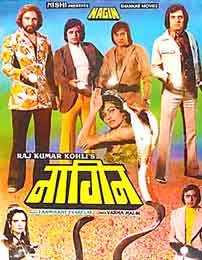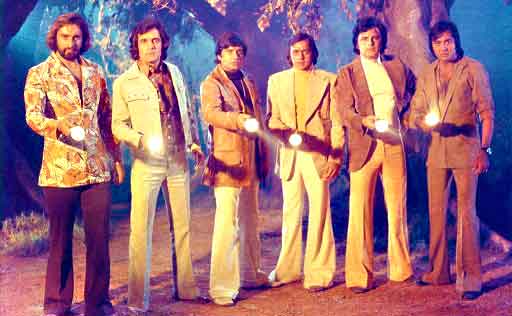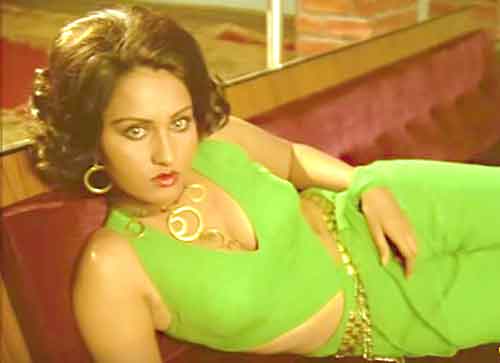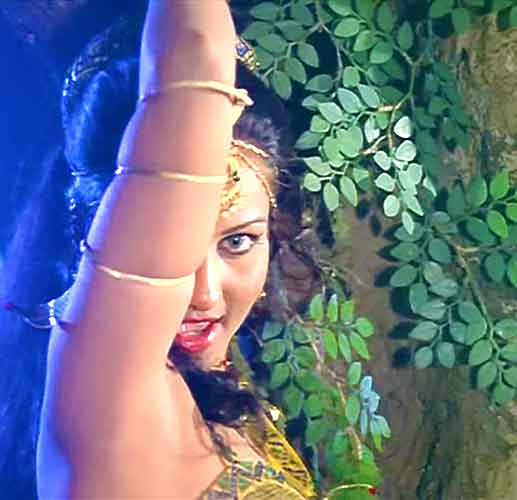 This enormously popular 1976 Hindi horror-fest, patterned after Francois Truffaut’s THE BRIDE WORE BLACK/La Mariée était en noir (1968), is summed up quite succinctly by the grammatically incorrect DVD summary: “Tells of the saga of revenge of an Ichadhari female cobra on five men who were responsible for killing her lover. She takes the form of women to kill four out of the five men. The fifth man succeeds in killing her.”
This enormously popular 1976 Hindi horror-fest, patterned after Francois Truffaut’s THE BRIDE WORE BLACK/La Mariée était en noir (1968), is summed up quite succinctly by the grammatically incorrect DVD summary: “Tells of the saga of revenge of an Ichadhari female cobra on five men who were responsible for killing her lover. She takes the form of women to kill four out of the five men. The fifth man succeeds in killing her.”
The cobra is played in human form by Reena Roy, who became an instant superstar due to NAGIN (and claimed that upon its initial release “people would run away from me screaming ‘Nagin has come!’”). She’s seen shrinking down to become a snake, and expanding to become a human, via special effects that are positively jaw-dropping (and not because they’re good).
The cobra is played in human form by Reena Roy, who became an instant superstar… and claimed that upon its initial release “people would run away from me screaming ‘Nagin has come!’”
Nagin (Full Film)
Regarding the five men—six, actually—she’s after, they’re hunters in a search of a snake-person. It seems that according to an ancient legend, outlined in the film’s opening moments, cobras are capable of assuming human form when they reach maturity. Nagin (Roy), a.k.a. Snake Woman, has reached that point, and is in the middle of a dance routine with her lover Nag (Jeetendra), a.k.a. Male Serpent—with whom, after a thousand year wait, Nagin is about to copulate. Thus she’s quite upset when one of the hunters, the impulsive Kiran (Anil Dhawan), fires the deadly shot that kills Nag, who’s still in snake form.
Kiran is, appropriately, Nagin’s first victim, with she assuming human form to seduce and kill him with her deadly venom. Nagin then turns her attentions to Kiran’s pals, titillating them in different hot chick guises and dispatching all but one.
The men try to evade Nagin by contacting a fakir, who provides necklace amulets capable of resisting Nagin’s powers. She, however, hits upon various ways to make them remove the necklaces, including ensnaring an innocent man who snatches it away and threatening the daughter of family man Suraj (Sanjay Khan). As he dies Suraj asks the upstanding Vijay (Sunil Dutt), the lone survivor of Nagin’s vengeance, to look after his young daughter Anu (Vishal Desai), to which Vijay readily agrees. This leaves Nagin with not one but two final targets.
Director Rajkumar Kohli specialized in Bollywood potboilers, some of which were quite successful (such as his 1979 follow-up to NAGIN, the nearly-as-popular JAANI DUSHMAN). NAGIN marked a nadir for Kohli, and Indian cinema; it was by no means the first Indian film about a snake-woman, nor the first to bear that title (with 1954 and ‘59 versions having preceded it), but it was iconic enough to inspire a flood of imitations, including the Tollywood production NEEYA (1979), the Sridevi starrer NAGINA (1986) and a 1998 Hindi language NAGIN TV series.
The film has a shamelessness that’s unique to Indian cinema, with outrageously dramatic music cues, lightning intercuts during the more horrific sequences, some truly hair-raising snake action (with actors situated in alarmingly close proximity to actual cobras) and a mind-roaster of a climax in which Vijay, Anu and Nagin are somehow caught on a rope strung between the upper floors of two high rises, and in view of hundreds of over-emoting extras—a sequence so insanely overblown and plain nutty it registers as a Bollywood tour de force.
The film has a shamelessness that’s unique to Indian cinema, with outrageously dramatic music cues, lightning intercuts during the more horrific sequences, some truly hair-raising snake action (with actors situated in alarmingly close proximity to actual cobras)…
The visuals are marked by an ultra-garish Dario Argento-esque color scheme, with red and blue filtered lighting given prominence. We also get copious song and dance numbers (most of them performed by Nagin and her lover in idyllic settings), your reaction to which will depend on your taste for Indian music. That’s a taste I admittedly have yet to acquire.
NAGIN’s most pressing problem is one that afflicts quite a few Bollywood films: its length, which at nearly two and a half hours is simply too damn long, especially given the simplemindedness of the narrative. Yet the film is very eager to please, offering up several gratuitous fistfights, some dumb-assed slapstick, much sappy romance and a great deal of an element that wasn’t present in too many pre-2000 Bollywood movies: overt sex appeal (something that was strictly controlled by Indian censors). The sensual dances and skimpy outfits worn by Reena Roy and the other actresses may not seem eyebrow-raising these days, but were envelope-pushing in 1976.
Vital Statistics
NAGIN
Shankar Films
Director/Producer: Rajkumar Kohli
Screenplay: Jaggiram Paul, Charanda Shokh
Cinematography: Baldev Singh
Editing: “Shyam” (Shyam Rajput)
Cast: Sanil Dutt, Feroz Khan, Vinod Mehra, Kabir Bedi, Anil Dhawan, Sanjay Khan, Rekha, Yogita Bali, Prema Narayan, Neelam Mehra, Reena Roy, Premnath Malhotra, Aruna Irani, Ranjeet Bedi, Heena Kausar, Roopesh Kumar, Vishal Desai



